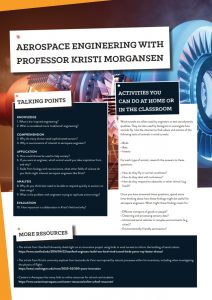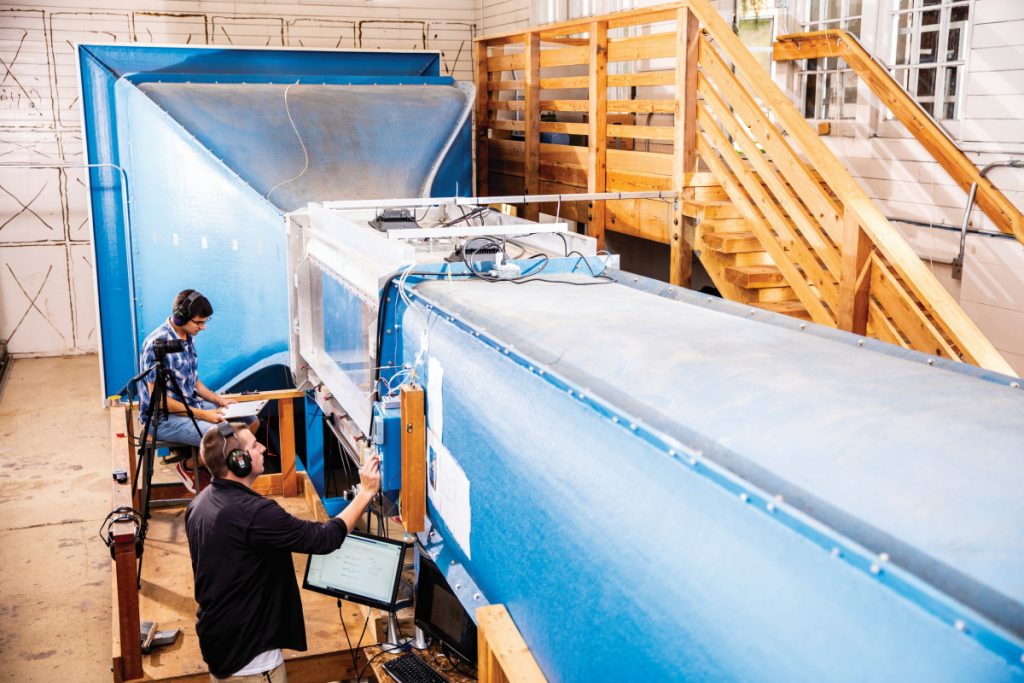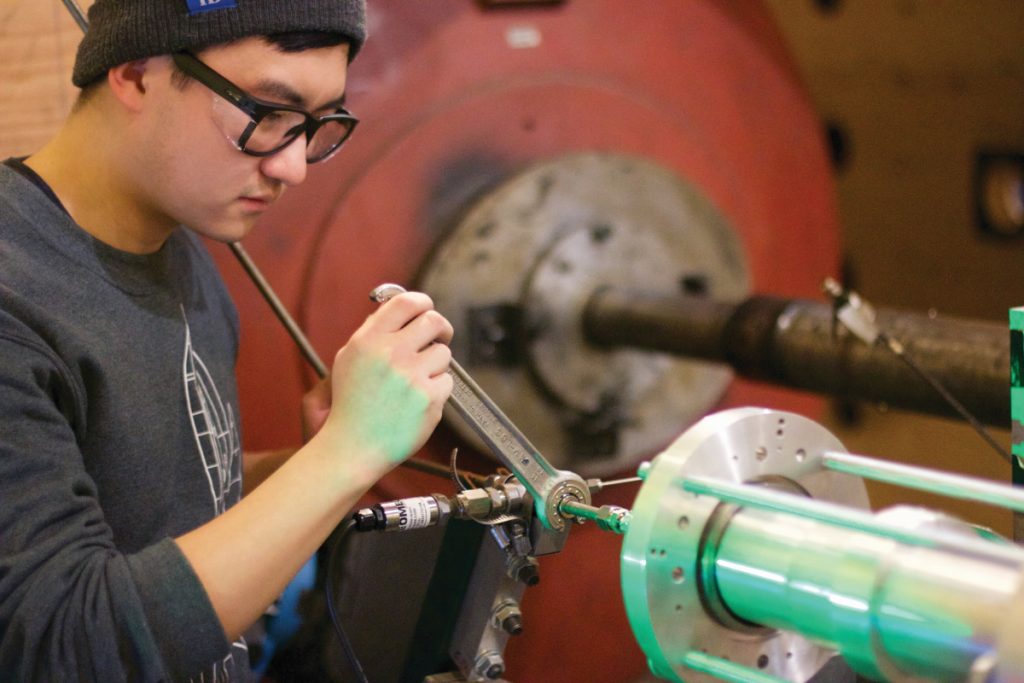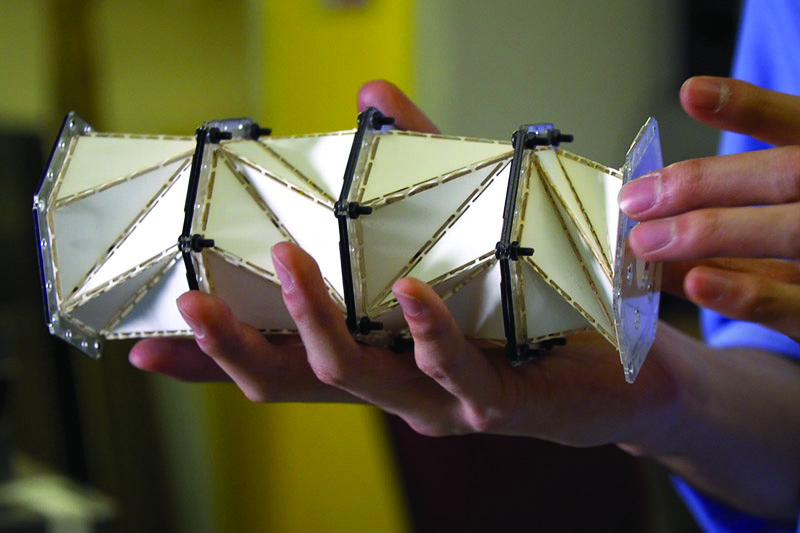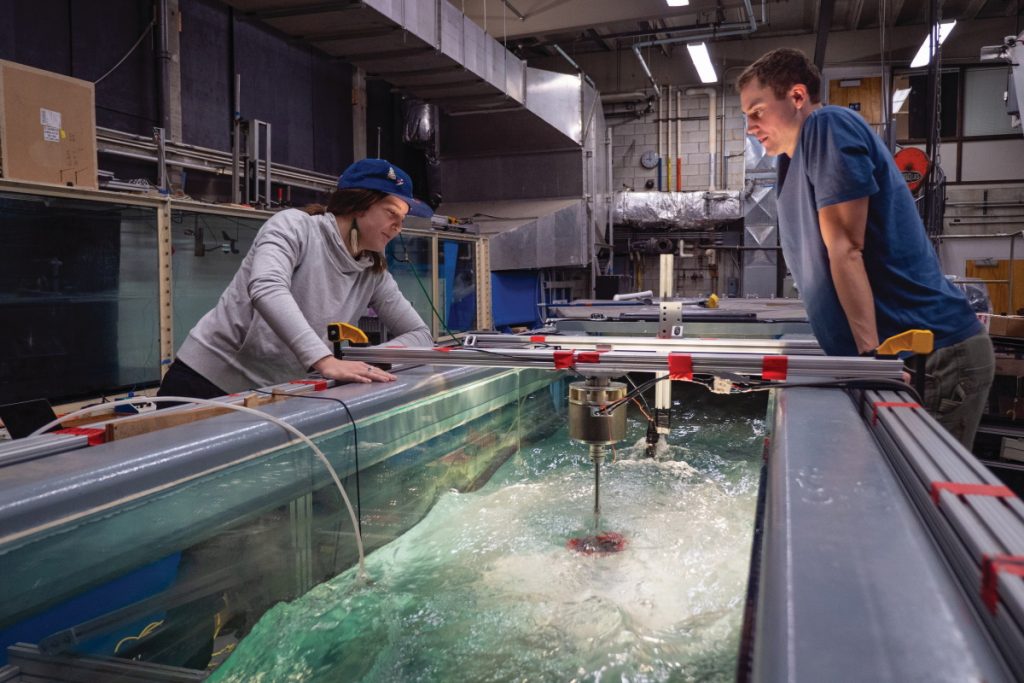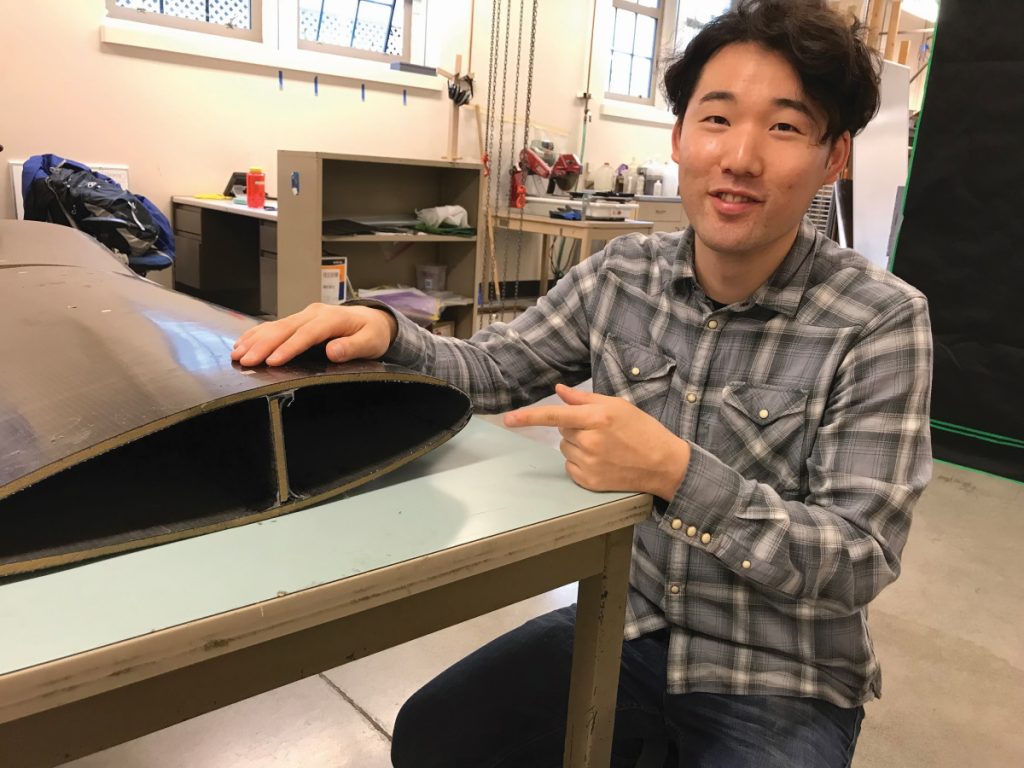The sky’s the limit: new horizons for aerospace
Scientists have been inspired by the natural world since time immemorial. Professor Kristi Morgansen, of the University of Washington in the US, is combining insights from nature with traditional engineering, discovering a world of new potential for our flying machines
TALK LIKE AN AEROSPACE ENGINEER
AERONAUTICS – the science of aircraft
AEROSPACE – the science of aircraft and spacecraft (i.e. aeronautics and astronautics)
AVIATION – the flying of an aircraft
SENSOR – a device (either biological or man-made) that detects or measures something about its environment
UNMANNED AERIAL VEHICLE (UAV) – an aircraft piloted by remote control or computers
The science of aviation and aerospace is constantly changing. In recent years, aerospace engineers have made big strides in developing more efficient aeroplanes, long-distance spacecraft, and intelligent drones, to name but a few. Such innovations require innovators. Professor Kristi Morgansen is a professor in the William E. Boeing Department of Aeronautics and Astronautics at the University of Washington, and is a pioneer of blue-sky thinking. By working with scientists from a wide range of disciplines, she is helping to push the limits of what aeronautics can achieve.
LOOKING TO NATURE
Humans have only been flying around for just over a century, but many animals have had it nailed for millennia. Birds, bats and insects all evolved flying mechanisms independently, and Kristi is intent on discovering how their methods could be applied to aeronautics. “Bio-inspired engineering is more exploratory and high-risk than traditional engineering,” she says. “I find this ‘try something crazy!’ aspect really exciting.”
Kristi takes a special interest in bats, the only mammals that can fly. “Bats are amazing! They essentially have a hand within their wing. There is a stretchy membrane beneath each ‘finger’ so they can dramatically change the shape of their wing as they’re flying – they can do some incredible manoeuvres.” This could have direct applications to aeronautics. As Kristi explains, “Aircraft are starting to use lighter materials, which makes them more energy-efficient but also more flexible. How do you control the shape of a flexible wing so it doesn’t flutter or distort? The animal kingdom could help answer that.”
Aircraft have already taken notes from nature. For instance, the little curved wing tips that you can see on aeroplanes is a feature seen in birds and bats. They help the wings to glide smoothly through the air and reduce drag. “I work in exploring what might work,” says Kristi. “Then, once the science has been established, traditional engineering methodology will take it from the design stage to a product.”
DRONE DEVELOPMENTS
Drones have opened up a huge new range of possibilities, from package delivery to supporting disaster areas. “We have looked into using unmanned aerial vehicles (drones) for search and rescue, or to get emergency supplies to victims of disasters such as earthquakes,” says Kristi. “The environments they find themselves in are often very complex – inner cities, for examples, can be full of obstacles – so developing effective sensors is a top priority.”
Kristi works with a company that is developing ‘morphing vehicles’. This is a drone with four rotors on arms that can change length and angles as the drone flies. For instance, if one rotor fails, the arms can reconfigure and rebalance the drone so it can continue flying with three rotors. Having effective sensors that can detect such changes, and having systems that can respond to them as rapidly as possible, is essential for these to work.
Such complex arrangements draw on data science, which is another interest of Kristi’s. “Sensors produce plenty of data, but how do we find it and how do we choose which data to use?” she asks. “This is especially true for autonomous vehicles that make their own decisions. We have to make sure the systems behave in the way we want them to.”
THE NERVOUS SYSTEM: NATURE’S FINEST DATA PROCESSOR
Once again, the natural world can help with this. The way that animals sense the world around them and make decisions accordingly is of great interest to Kristi. Bats, for instance, can make decisions in a fraction of a second based on what sensors on their wings are telling them. “I work with biologists and neuroscientists. I love working with people from other fields,” says Kristi. “We look at how animals’ brains process information and how we can translate this to machines. There’s a lot of interesting stuff happening!”
Of course, not everything in nature is directly applicable. Animals fly through flapping their wings, whereas aircraft function based on propulsion, for instance. “We’re not trying to replicate flapping wings, because people would get very motion sick, not to mention other issues it would pose,” says Kristi. “However, we are looking at ways that we can be more efficient with data processing, energy and computation. Sensors have a big role to play in this, and we hope to test our findings within commercial aircraft soon.”
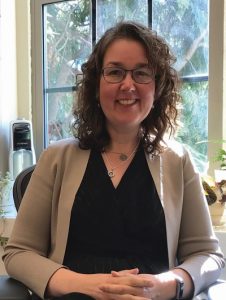 PROFESSOR KRISTI MORGANSEN
PROFESSOR KRISTI MORGANSEN
William E. Boeing Department of Aeronautics and Astronautics, University of Washington, Seattle, USA
FIELD OF RESEARCH: Aeronautics and Astronautics
RESEARCH PROJECT: Focusing on sensory systems for flying vehicles, drawing inspiration from biology and neuroscience.
FUNDERS: Joint Center for Aerospace Technology Innovation
US Federal Aviation Authority
ONR grant numbers N00014-10-1-0952 & N00014-17-1-2623
AFOSR grant number FA9550-14-1-0398
ABOUT AERONAUTICS AND ASTRONAUTICS
Aeronautics covers the science behind building and flying aircraft. Astronautics covers a similar field but for beyond the Earth’s atmosphere – the science spacecraft and space exploration. Aerospace is a catch-all term that covers both. Through her interactions with other disciplines, Kristi’s work goes beyond these straightforward definitions. She explains more about what her working life is like:
WHAT MOTIVATES YOU?
I don’t really get bored. I like problem solving and I love the intersection between mathematics and engineering. I love coming up with a mathematical representation of something, predicting what this thing will do in the real world, and then demonstrating it. If it does work as expected, great – if it doesn’t, I like to discover why. I love seeing the application of maths and physics – it never gets old!
WHAT CHALLENGES DO YOU FACE IN YOUR WORK?
There are only 24 hours in a day, which is annoying! The pandemic has also made it difficult to get into the lab. Working with different people can have its challenges, as people respond to different styles of communication. Managing a large group of people is also challenging, though this brings its own joys too. The days of scientists working on their own are long gone. The old-fashioned perception of engineers working alone has led to a lack of diversity and bias, which can only be changed through collaboration.
Reference
https://doi.org/10.33424/FUTURUM114
AERONAUTICS – the science of aircraft
AEROSPACE – the science of aircraft and spacecraft (i.e. aeronautics and astronautics)
AVIATION – the flying of an aircraft
SENSOR – a device (either biological or man-made) that detects or measures something about its environment
UNMANNED AERIAL VEHICLE (UAV) – an aircraft piloted by remote control or computers
The science of aviation and aerospace is constantly changing. In recent years, aerospace engineers have made big strides in developing more efficient aeroplanes, long-distance spacecraft, and intelligent drones, to name but a few. Such innovations require innovators. Professor Kristi Morgansen is a professor in the William E. Boeing Department of Aeronautics and Astronautics at the University of Washington, and is a pioneer of blue-sky thinking. By working with scientists from a wide range of disciplines, she is helping to push the limits of what aeronautics can achieve.
LOOKING TO NATURE
Humans have only been flying around for just over a century, but many animals have had it nailed for millennia. Birds, bats and insects all evolved flying mechanisms independently, and Kristi is intent on discovering how their methods could be applied to aeronautics. “Bio-inspired engineering is more exploratory and high-risk than traditional engineering,” she says. “I find this ‘try something crazy!’ aspect really exciting.”
Kristi takes a special interest in bats, the only mammals that can fly. “Bats are amazing! They essentially have a hand within their wing. There is a stretchy membrane beneath each ‘finger’ so they can dramatically change the shape of their wing as they’re flying – they can do some incredible manoeuvres.” This could have direct applications to aeronautics. As Kristi explains, “Aircraft are starting to use lighter materials, which makes them more energy-efficient but also more flexible. How do you control the shape of a flexible wing so it doesn’t flutter or distort? The animal kingdom could help answer that.”
Aircraft have already taken notes from nature. For instance, the little curved wing tips that you can see on aeroplanes is a feature seen in birds and bats. They help the wings to glide smoothly through the air and reduce drag. “I work in exploring what might work,” says Kristi. “Then, once the science has been established, traditional engineering methodology will take it from the design stage to a product.”
DRONE DEVELOPMENTS
Drones have opened up a huge new range of possibilities, from package delivery to supporting disaster areas. “We have looked into using unmanned aerial vehicles (drones) for search and rescue, or to get emergency supplies to victims of disasters such as earthquakes,” says Kristi. “The environments they find themselves in are often very complex – inner cities, for examples, can be full of obstacles – so developing effective sensors is a top priority.”
Kristi works with a company that is developing ‘morphing vehicles’. This is a drone with four rotors on arms that can change length and angles as the drone flies. For instance, if one rotor fails, the arms can reconfigure and rebalance the drone so it can continue flying with three rotors. Having effective sensors that can detect such changes, and having systems that can respond to them as rapidly as possible, is essential for these to work.
Such complex arrangements draw on data science, which is another interest of Kristi’s. “Sensors produce plenty of data, but how do we find it and how do we choose which data to use?” she asks. “This is especially true for autonomous vehicles that make their own decisions. We have to make sure the systems behave in the way we want them to.”
THE NERVOUS SYSTEM: NATURE’S FINEST DATA PROCESSOR
Once again, the natural world can help with this. The way that animals sense the world around them and make decisions accordingly is of great interest to Kristi. Bats, for instance, can make decisions in a fraction of a second based on what sensors on their wings are telling them. “I work with biologists and neuroscientists. I love working with people from other fields,” says Kristi. “We look at how animals’ brains process information and how we can translate this to machines. There’s a lot of interesting stuff happening!”
Of course, not everything in nature is directly applicable. Animals fly through flapping their wings, whereas aircraft function based on propulsion, for instance. “We’re not trying to replicate flapping wings, because people would get very motion sick, not to mention other issues it would pose,” says Kristi. “However, we are looking at ways that we can be more efficient with data processing, energy and computation. Sensors have a big role to play in this, and we hope to test our findings within commercial aircraft soon.”
 PROFESSOR KRISTI MORGANSEN
PROFESSOR KRISTI MORGANSEN
William E. Boeing Department of Aeronautics and Astronautics, University of Washington, Seattle, USA
FIELD OF RESEARCH: Aeronautics and Astronautics
RESEARCH PROJECT: Focusing on sensory systems for flying vehicles, drawing inspiration from biology and neuroscience.
FUNDERS: Joint Center for Aerospace Technology Innovation
US Federal Aviation Authority
ONR grant numbers N00014-10-1-0952 & N00014-17-1-2623
AFOSR grant number FA9550-14-1-0398
ABOUT AERONAUTICS AND ASTRONAUTICS
Aeronautics covers the science behind building and flying aircraft. Astronautics covers a similar field but for beyond the Earth’s atmosphere – the science spacecraft and space exploration. Aerospace is a catch-all term that covers both. Through her interactions with other disciplines, Kristi’s work goes beyond these straightforward definitions. She explains more about what her working life is like:
WHAT MOTIVATES YOU?
I don’t really get bored. I like problem solving and I love the intersection between mathematics and engineering. I love coming up with a mathematical representation of something, predicting what this thing will do in the real world, and then demonstrating it. If it does work as expected, great – if it doesn’t, I like to discover why. I love seeing the application of maths and physics – it never gets old!
WHAT CHALLENGES DO YOU FACE IN YOUR WORK?
There are only 24 hours in a day, which is annoying! The pandemic has also made it difficult to get into the lab. Working with different people can have its challenges, as people respond to different styles of communication. Managing a large group of people is also challenging, though this brings its own joys too. The days of scientists working on their own are long gone. The old-fashioned perception of engineers working alone has led to a lack of diversity and bias, which can only be changed through collaboration.
I think that attracting a broader range of people, including those from underrepresented minorities, should be a key focus. Modern-day lifestyles should not be all about work, and we should accommodate this, otherwise we miss out on talented people. For instance, the pandemic has highlighted the challenge of childcare. We shouldn’t expect people to work long hours every day, and the sector needs more flexibility in how we engage with people. We are making progress, but there is still a way to go.
WHAT IS YOUR KEY MESSAGE ABOUT YOUR WORK?
I am not at the beginning of my career. The sort of broad-scale work that I do is not always available for engineers at the start of their working life. But this does not mean it is unattainable; by building your skills as you go along, you can work towards securing your perfect role.
As an undergraduate, you learn the fundamentals of your subject and how to apply them. As a master’s student, you go into more depth in your field, and then, for your PhD, you’re looking for something novel. You keep progressing as your career progresses – that’s what makes it so rewarding.
HOW TO BECOME AN AEROSPACE ENGINEER
• Investigate universities with aerospace engineering, aeronautics and astronautics programmes or mechanical engineering departments with aerospace programming.
• Enrol in a related engineering discipline at university and enter the field through an internship or specialised entry position with an aerospace company. Businesses such as BAE Systems, Airbus, Rolls-Royce, Messier-Dowty and Goodrich run aerospace apprenticeships, as do NASA, the European Space Agency (ESA) and Lockheed Martin.
• According to Career Explorer, the average salary for an aerospace engineer in the US is $110,000 per year.
Kristi recommends taking mathematics as a priority. She also advocates computer science, highlighting the importance of programming within many disciplines. Physics is also required by many university courses, and other sciences are also useful.
Some university degrees specialise in aerospace engineering. Otherwise, degrees in electrical engineering, mechanical engineering, product engineering, software engineering, physics or mathematics can all lead to a career in this area.
HOW DID KRISTI BECOME AN AEROSPACE ENGINEER?
WHAT WERE YOUR INTERESTS AS A CHILD?
When I was young, I enjoyed tackling puzzles and solving problems. I liked being outdoors and loved reading. I became interested in space fairly early on, but I didn’t know what direction that would take until much later.
WHAT INSPIRED YOUR CAREER PATH?
My eureka moment was during my undergraduate degree. My advisor had been working with me on the application of mathematics into physical systems, because he knew it was an area I was very interested in. He suggested I go to graduate school, which hadn’t occurred to me until then. At that point, I started working in a robotics lab in a summer research programme and realised that this sort of science was what I wanted to do long-term.
WHAT ATTRIBUTES HAVE HELPED YOU BECOME SUCCESSFUL?
I’m pretty tenacious, and don’t give up easily. This is useful as there are always obstacles within research. I like being creative and exploring things.
HOW DO YOU SPEND TIME OUTSIDE OF WORK?
It can be hard to switch off – one method I use is reading murder mysteries at night!
KRISTI’S TOP TIPS FOR STUDENTS
01 Find mentors. People who can help you develop your technical, professional and interpersonal skills are invaluable. You can never have enough mentors!
02 Learn how to study. For many, it’s not a natural thing, but it can be learned. It’s not a case of ‘you have it or you don’t’ – you can learn it and develop your stamina.
03 Find things that excite you. If you’re not excited by it, don’t pursue it!
Write it in the comments box below and Kristi will get back to you. (Remember, researchers are very busy people, so you may have to wait a few days.)


